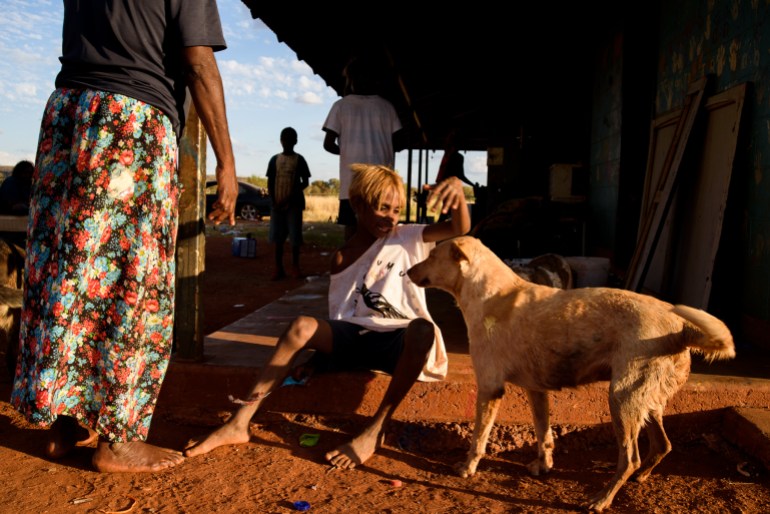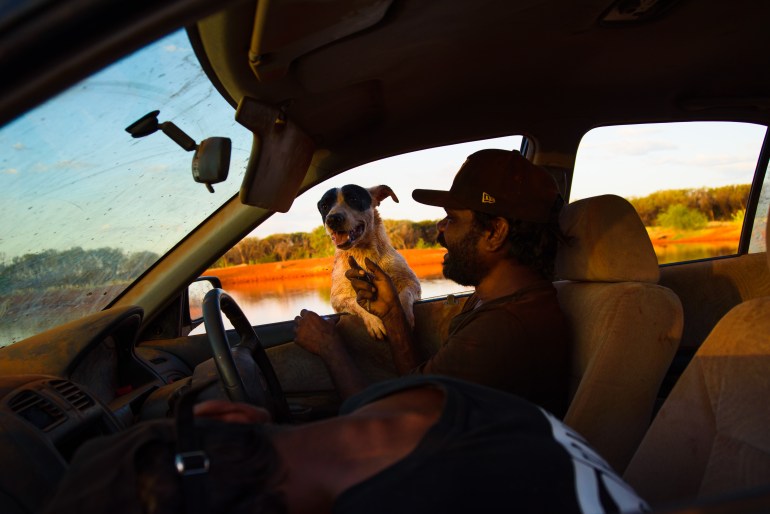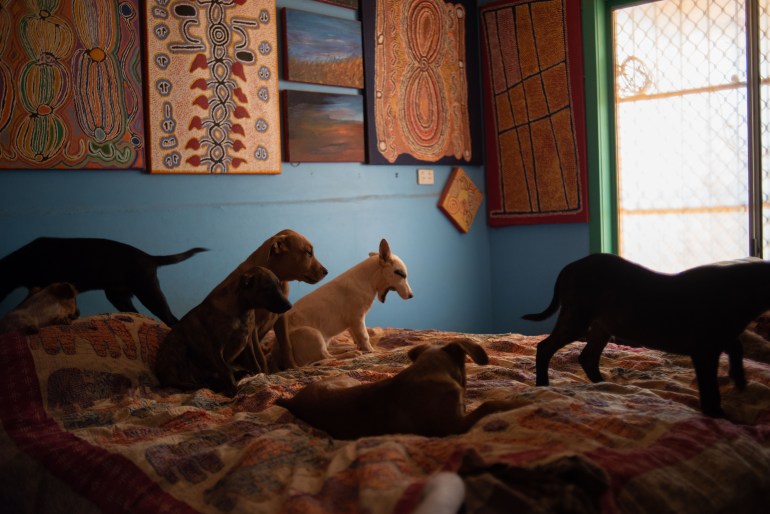[ad_1]
Twenty years ago, when Gloria Morales arrived in Yuendumu, a remote community in Australia’s Northern Territory, “there were dead dogs everywhere,” she recalls.
An overpopulation crisis left dogs starving, sick and covered in mange. They were unvaccinated, malnourished, easily infected with bacteria, and their puppies died of infections. Many of the dogs were also aggressive, fighting and killing each other for territory and food. Like many of Australia’s remote Indigenous communities, Yuendumu had no vet and the nearest one was in Alice Springs, about 300km away.
It took Morales a long time to gain people’s trust. But for the past several decades, she has lived an extraordinary life in Yuendumu, dedicated to the promotion of indigenous arts and the transformation of the community’s dog population.
Dogs are especially prominent in Aboriginal communities where dog ownership is much higher than the national average in Australia. According to one survey, 65 percent of Aboriginal households claimed ownership of at least one dog.
While the “dingo” – a word derived from the Aboriginal Dharug language – arrived in Australia about 5,000 years ago, the domesticated dogs arrived later with European settlers. English botanist Joseph Banks first entered Botany Bay in 1770 with two greyhounds on board.
Dingo burials found at archaeological sites provide some insight into the long relationship between their modern-day semi-feral descendants and Australia’s aboriginal communities.
In her observation of the relationship between the Warlpiri people of Yuendumu and their dogs, anthropologist Yasmine Musharbash writes of the role as akin to a family member and protector, “warning a camp of the arrival of strangers, be they humans or ghosts” .
In Warlpiri folklore, it is their dogs that can sense and smell the presence of the Jarnpa, a kind of invisible monster with superhuman strength and a penchant for killing.

“Japa [Walpiri] people love dogs because they protect us. Don’t let us be lonely. Dogs are like a shadow to Warlpiri people,” local artist Vanetta Nampijinpa Hudson told Al Jazeera.
Our dogs “follow us everywhere,” she says.
“Toilet and bathroom, everywhere!”
Dingoes and dogs
Dogs and dingoes figure prominently in Warlpiri rituals, stories and songlines.
The camp dogs that roam free in Yuendumu are the result of crossing dogs and dingoes. To describe it as wandering might imply an aimlessness, while Yuendumu’s dogs trot with determination, seemingly always watching and on guard. It is also not uncommon to see a community member followed by a large pack of dogs.
“When white people come to Yuendumu, they are afraid of all dogs everywhere. They think those dogs are going to bite them,” says Nampijinpa Hudson.
“They don’t need to be afraid because the dogs here aren’t too bold,” she says.
That’s because they’re not hungry. Gloria [Morales] brings in food. In other communities, those dogs can be really sassy and crazy.”
![Trevor Jupurrurla Walker with his daughter and dog Creamy [Courtesy of Francis Macindoe/Warlukurlangu Artists]](https://www.aljazeera.com/wp-content/uploads/2023/04/Trevor-Jupurrurla-Walker-with-his-daughter-and-dog-Creamy-1-1682755680.jpg?w=770&resize=770%2C514)
Before moving to Yuendumu in 2003, Morales worked at the National Gallery in Canberra as curator of the Aboriginal collection. And though she came to take on a position as assistant manager at the local arts center, it was Yuendumu’s canine problems that would consume her.
When she spoke about animal management, she was initially met with suspicion in the community. That was perhaps to be expected.
Morales grew up in the Chilean countryside of South America. But it was “very like this,” she says, pointing to the red soil of the Australian outback.
Morales started talking to the locals and over time built their trust.
“People noticed it wasn’t that I didn’t want the dogs, it was that I wanted to make them better,” she says.
“In the past, they put to sleep the dogs that were easy to reach, the friendliest, the ones that people wanted,” she says.
“I heard about a community manager who said, ‘Tie up the dogs you don’t want to a tree,’” she says. But “those were the dogs that were shot by the police”.
In consultation with the community, she began working with a veterinarian to reduce the population, give the dogs birth control implants, and identify those who were unwanted because they were aggressive, sick, or suffering.
Yuendumu’s dog lady
“Healthy dogs mean healthy people,” says the dog program of Warlukurlangu Artists – one of Australia’s longest-running Aboriginal art centers.
Morales set up the program in partnership with the Warlukurlangu Center and later with other organizations that help fund her work to care for the community’s dogs. It offers free dog food, health care and regular vet visits. Due to the success of the program, dogs are rarely euthanized.
Working with volunteers, Morales also founded Aussie Desert Dogs, an adoption program that places local rescue dogs in homes across Australia.
While organizations such as Animal Management in Rural and Remote Indigenous Communities provide veterinary services to remote communities, injuries don’t just happen when a vet comes to town, she says.

When she first arrived in the community, Morales tells how she was approached by an elderly woman who hesitantly asked if she could watch her dog. The dog was salivating and couldn’t eat. She put her hand in the dog’s mouth and pulled a bone from its jaw.
“And that was the solution,” she says.
And so began the visits with people bringing their dogs for treatment. A woman whose dog had a bloodied eyelid torn and gone limp from a fight asked if she could stitch it up. Since there were no surgical stitches on hand, Morales got some needles and thread.
“It worked!” she laughed, as if still surprised by her performance. “People realized I was there to help them.”
Today she is known as Yuendumu’s dog lady and her home has become the local animal shelter.
At all hours of the day, people knock on her door with sick or injured animals, not just dogs. Kangaroos, wild horses, snakes, turtles, birds, wedge-tailed eagles, finches and goannas (a type of lizard).
Morales has no formal veterinary training and researches medical treatments for animals. Sometimes he goes through a difficult procedure with a vet via video calls.
It would be a better solution to have a veterinary nurse work full-time in the community, she says, recounting how a new deadly bacteria that was transmitted by tics came into the community a few years earlier.
“You need someone to go around and see which dogs need treatment,” she says.
‘nobody else does’
Ever since she was a child, animals have been attracted to Morales. She tells a story about a neighbor’s dog in Chile who would see her coming home on the school bus and race towards her. The neighbor would say, “I know when Gloria is home because my dog doesn’t, and he won’t come back until she’s gone.”
Morales now shares her home with 47 dogs. It is well equipped with a large outdoor area for them to run, play and eat.
The most vulnerable, and those prone to being attacked by other dogs, can stay indoors. You have breathing difficulties. Another is old and crippled after being run over several times. The one with a brain tumor, whose face is twisted, sleeps on her bed.
“He eats all his food and he’s happy to see me,” she says of the dog. “I talk to him. He will let me know when he doesn’t want to live anymore.”

Then there’s the paralyzed dog she takes for walks in a wheelchair. In her bathroom, a brain-damaged dog walks circles, with a few puppies to keep him company. The other puppies are wreaking havoc in the house. They poop everywhere and chew on everything.
Morales comes back from work and assesses the damage: “What did they destroy today?”
After her work is done each night, Gloria throws veggies and chicken into a giant pot. The next morning she adds rice so the dogs have a chilled, cooked meal when she gets home. She doesn’t sleep much and her arms are scarred from dog bites over the years.
“I just go to the clinic and get antibiotics,” she says of those injuries.
Does she ever wonder why she’s doing it? Are Yuendumu’s dogs worth it?
“I’m not going ‘oh my god I’m so tired’ or whatever,” she says.
“It just has to happen and no one else is going to do it.”
[ad_2]
Source link